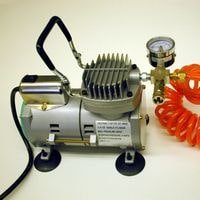Introduction:

Image: www.familyhandyman.com
In the heart of any industrial or construction site, there hums the indispensable air compressor, powering tools and machines to bring forth countless projects. However, this lifeline of compressed air often faces a formidable foe: water. Water can wreak havoc on an air compressor system, causing costly breakdowns and potentially dangerous situations. This article delves into the perils of water in compressor lines and offers a comprehensive guide to keeping those lines dry and functional.
The Perils of Water in Compressed Air Systems:
Water in compressed air lines poses a dire threat to the system’s overall integrity and functionality. This insidious moisture can lead to corrosion, rust within pipes and equipment, and the formation of ice in cold temperatures. Corrosion damages the vital metal components, leading to weakened lines, leaks, and eventual failures. The resulting downtime can halt operations and result in substantial financial losses.
Moreover, water droplets can cause downstream tools and equipment to malfunction or even break down. The presence of water in pneumatic tools, for instance, can lead to their premature deterioration, forcing expensive replacements and hindering productivity.
Step-by-Step Guide to Keeping Water Out of Air Compressor Lines:
Confronting this threat requires a systematic approach:
1. Air Dryer Installation:
At the pinnacle of water defense stands the air dryer. This marvel of engineering extracts moisture from compressed air, preventing it from entering the lines. Drains are installed at the bottom of the dryer to eliminate the collected water regularly.
2. Regular Drain Valve Maintenance:
Drain valves, the unsung heroes of air lines, automatically discharge water condensation from the system. Ensuring they are fully functional is crucial. Timely draining prevents water accumulation and its detrimental effects.
3. Proper Insulation of Lines:
Insulating air compressor lines is a proactive measure that helps maintain air temperature above the dew point, reducing the likelihood of water condensation. By preventing drastic temperature drops, insulation shields the system from the formation of water droplets.
4. Strategic Installation of Aftercoolers:
An aftercooler is a device that cools the compressed air coming from the compressor. This cooling process condenses water vapor, which is then eliminated through the drain system. Installing aftercoolers close to the compressor helps prevent water vapor from reaching the lines.
5. Water Separators:
Another line of defense against water lies in the form of water separators. These devices utilize a filtration system to isolate and remove water droplets from the compressed air before they can wreak havoc.
6. Monitoring and Warning Systems:
Equipping the air compressor system with sensors that monitor moisture content in the air is a proactive strategy. These sensors sound an alarm or trigger corrective actions when water levels reach a critical threshold, allowing for timely intervention.
Conclusion:
Water may seem innocuous, but it wields the power to compromise the integrity and efficiency of air compressor systems. By following the comprehensive measures outlined in this guide, you can safeguard your air compressor lines from the detrimental effects of water and ensure their dependable, long-lasting performance. Take these steps today and let your air compressor breathe easy, powering your operations to success.

Image: noshhealthykitchen.com
How To Keep Water Out Of Air Compressor Lines